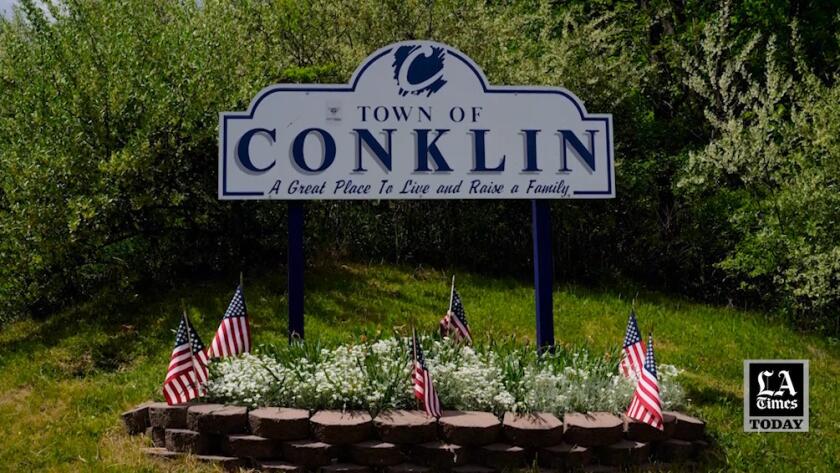
- Share via
CONKLIN, N.Y. — This corner of upstate New York is threaded by roads winding up from the banks of the Susquehanna River into low, tree-covered hills. Commuters choose this community for its good schools and proximity to jobs in Binghamton, often settling in developments marked by vast lawns, expansive views and two-car garages.
Others are drawn to Conklin’s country feel and rustic rhythms. There’s a sod farm near where the main drag meets the Pennsylvania border, and a produce operation on the way out of town headed north. Fishing for smallmouth bass in the Susquehanna is a favorite pastime, and it’s not unusual for locals to wear camo to the Dollar Tree.
It’s a small enough place that purchasing a stump grinder and issuing permits for mobile home communities constitute major agenda items at town meetings. Conklin has long enjoyed — even taken pride in — its speck-on-the-wall anonymity, a town unnoticed by and unconcerned with most of the outside world.
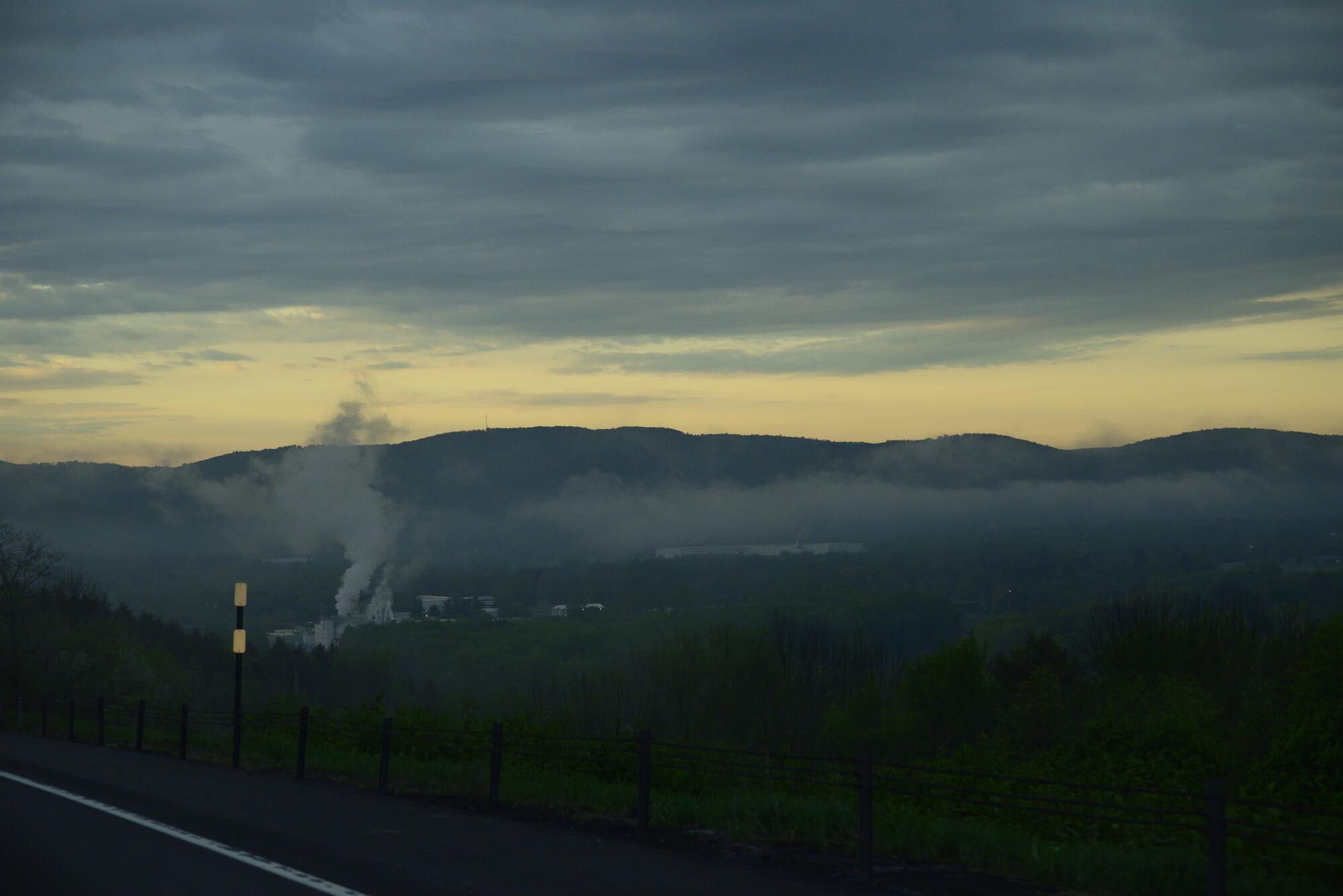
But the world and its messiness landed fiercely here on Saturday when one of Conklin’s own, 18-year-old Payton Gendron, a former worker in a local deli, allegedly killed 10 people and wounded three more in a racially motivated shooting 3½ hours away in Buffalo. An avowed white supremacist, Gendron, who wrote a 180-page manifesto to explain his views and the carnage they would unleash, is the son of a town that doesn’t know how to explain him.
His rage, according to police, played out in hate-filled online netherworlds populated by mostly young men who spout venom, crave attention and are becoming an increasing danger in towns like this, where extremism is seeping into the mainstream even as mass shootings across the nation have become so common that the response to them is almost rote.
“It’s an awful way to get our name on the map,” said Bob Green, a longtime resident.
Ninety percent of Conklin’s just over 5,000 residents are white. That’s down from 96.8% in 2010, largely because of an increase in its multiracial and Latino populations, according to the most recent census. The number of Black residents has fallen from 56 to 52, census data showed.
Lilly Freer has grown up with this whiteness and what she and others see as widespread intolerance fed by insularity. She was in Gendron’s graduating class at Susquehanna Valley High School. She said “he was always a nice, smiling face,” though she was not friends with him. She said that she believes “people are brought up to hate,” and that racism is not a rare trait in their hometown.
“I do know a lot of people in the Conklin area that went to school with him and have a lot of hateful views, whether it being them trying to be ‘cool’ or just them actually being hateful towards people or things,” she said.
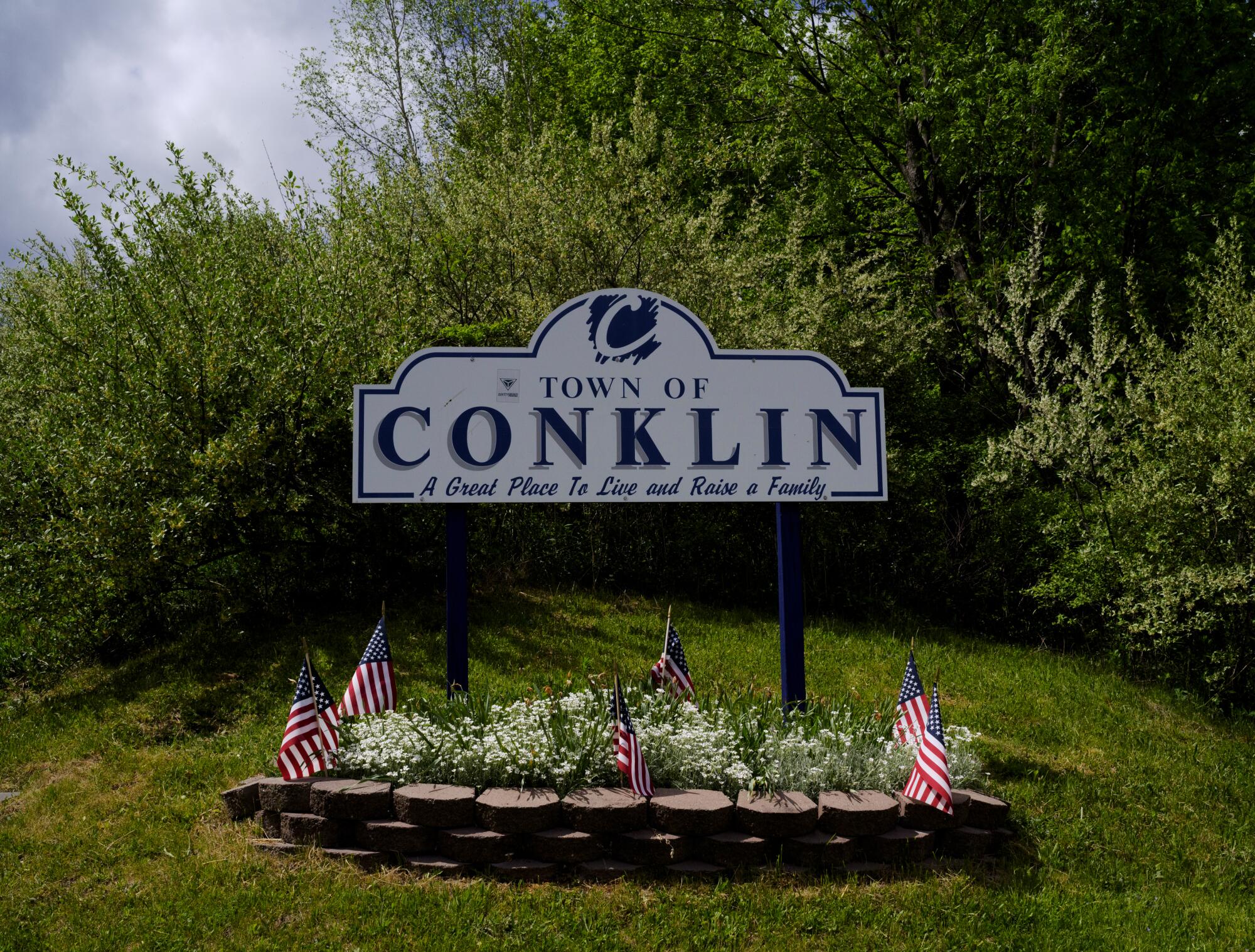
Not everyone feels that way. Robbie Miller said he had classes with Gendron, but they were not “exactly friends.” Similar to Freer, he described Gendron as “a really happy guy,” and he said he did not “think anyone that knew Payton thought he would be capable of doing this.” And Miller said he did not believe the place where Gendron grew up was a contributing factor in his extremist views.
“Conklin is a very good and quiet area,” he said. “I wouldn’t say his surroundings had anything to do with the situation.”
But for some those surroundings can appear cruel. Osha Mabilog emigrated with her family from the Philippines to a small town about six miles north of Binghamton when she was 13. Now 18, she’s a student at SUNY Broome Community College, which Gendron briefly attended before dropping out in March. Mabilog said that as a person of color she feels unsafe in many peripheral areas of the city, including Conklin.
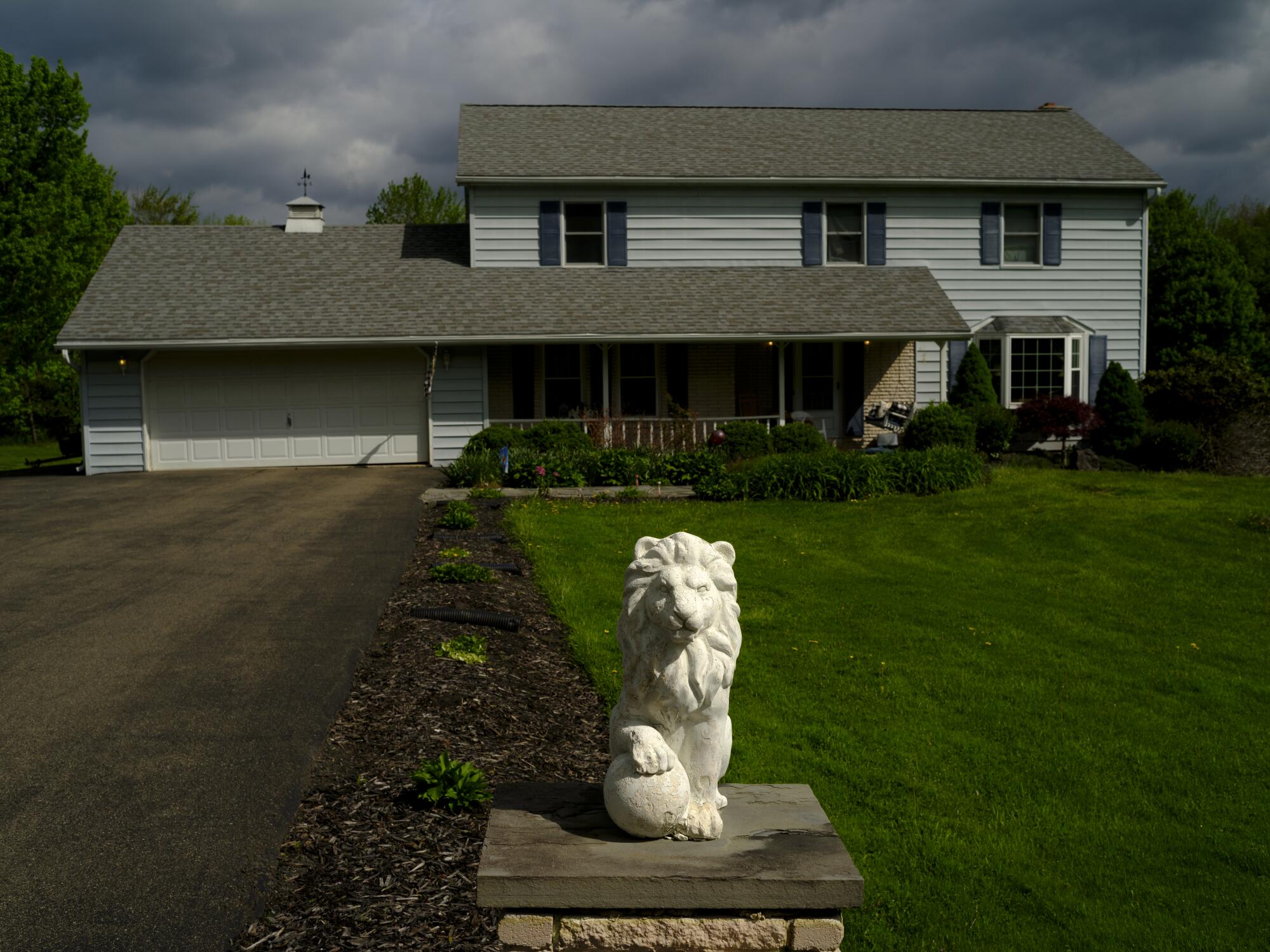
She was nervous to talk to a reporter, but said she wanted to raise awareness about the racist attitudes she encounters here.
“I see people’s eyes looking at me because I’m not white. In the white Republican areas near Binghamton, I won’t say that they’re all racist, but a good chunk of them are,” Mabilog said. “I don’t typically go to that area because I don’t know what’s going to happen so I’m not going to risk it.… I kind of know where to go and where not to go.”
Victoria Fleury, a white 19-year-old who also attends SUNY Broome, said she has repeatedly witnessed overt racism both in rural areas around Binghamton and in Greene, the small community where she grew up about 18 miles north of the city.
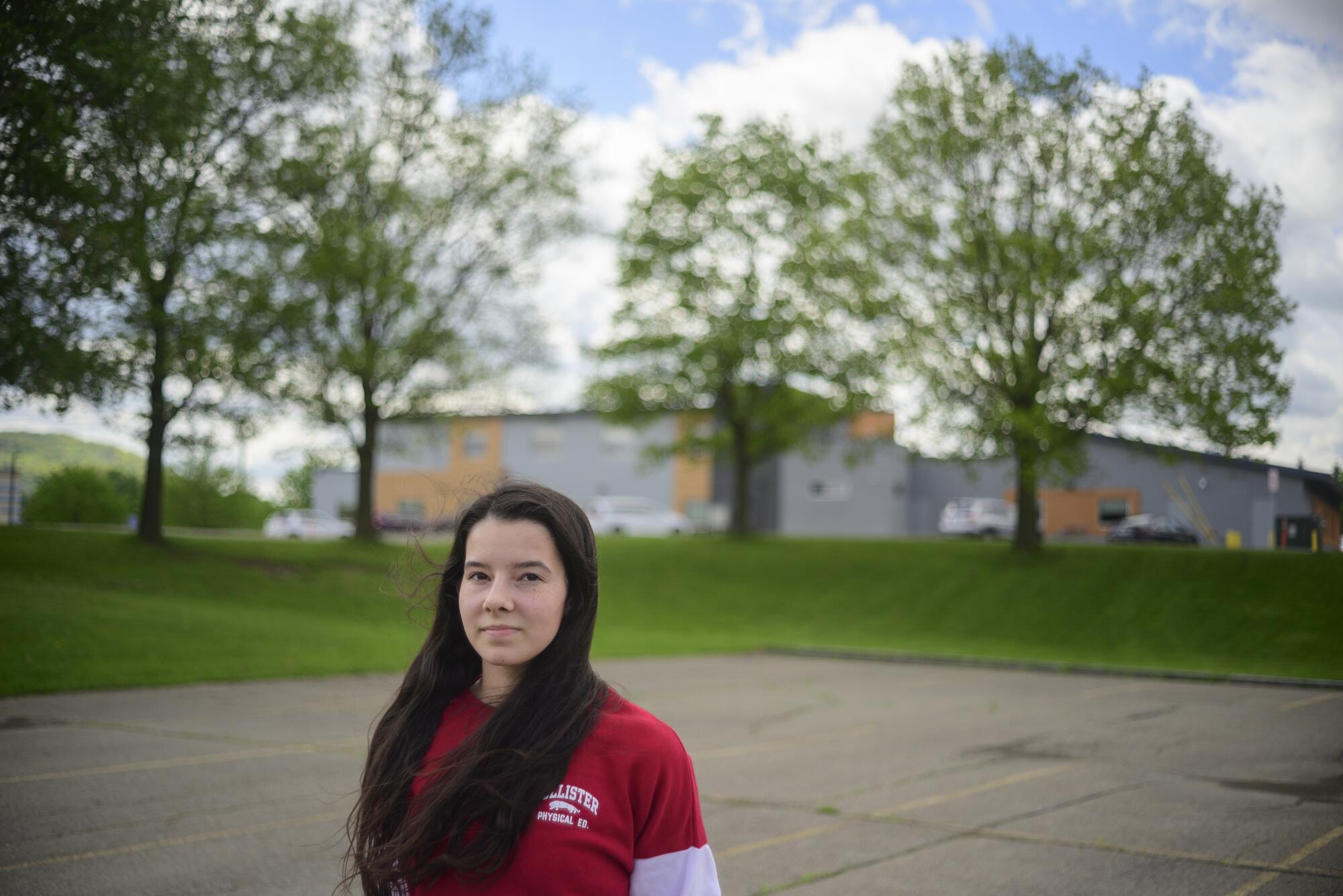
“People say the N-word left and right. It’s people thinking they’re funny, and then there’s people using it against people of color. It’s very common to hear it in school and also from older people,” she said. “I think it’s the lack of diversity.”
In Conklin and similar communities outside Binghamton, distrust of media and fear of reprisal for talking freely are common, especially among older residents. Time and again this week, people shared their opinions before declining to provide their full names. They live in a slice of America — like many others — that often appears resistant and at times resentful of a nation changing around them, a notion that has fueled the steady rise of identity politics.
Debbie has lived across the Susquehanna from Conklin in Kirkwood — an 89.4% white town of about 5,480 people as of the 2020 census — for most of her life. As the 65-year-old sat on a park bench overlooking the river on Tuesday, she laid out a warped version of reality that echoes the “replacement theory” that was included in a document Gendron allegedly posted online before the Buffalo massacre.

“We are minorities today. We’re down here and they’re up there in the world,” she said, referring to white and Black people, respectively. “Blacks can get what they want, and they can get a job because they use their race. I think that’s probably driving how white people feel today.”
Debbie, who declined to give her last name, said she believes that sentiment was likely a key driver of Gendron’s descent into extremism.
“That kid, he’s feeling all that,” she said. “That’s, in my opinion, why he probably felt that way is because of how it’s going with Black people lately.”
Gendron’s parents’ home sits on a dead-end street across from the meandering Carlin Creek. Tall deciduous trees line the lightly trafficked streets of their hilly subdivision and, like the Gendron house, most of the homes are well kept, two stories and set back from the road by big yards.
Though both of Gendron’s parents are engineers — for a time the career path he planned to follow — the family is split along political lines. State voting records show that his mother is a registered Republican and his father is registered as a Democrat.
Their community too is divided. In Broome County, home to Conklin and Binghamton, Joe Biden garnered 50.6% of the vote in the 2020 presidential election, while Donald Trump received 47.2%, according to county election data.
But unsurprisingly, as a relatively rural community, Conklin is redder than the overall county. That year, 60.3% of the votes in Gendron’s hometown were for Trump and 37.4% for Biden.
Here in Conklin, even unrelated conversations often turn to the assertion that President Biden and/or socialism are destroying America. A local bar, Jumbo’s No. 1, has a sign next to the liquor shelves that reads, “This place is politically incorrect,” and lists several terms that “we say,” including “Merry Christmas” and “One nation under God.” It goes on to state, “We salute our flag & give thanks to our troops,” and warns patrons that “if this offends you LEAVE.”
Such rhetoric and posturing don’t sit well with some Conklin residents. Several of the town’s self-identified liberals said they feel that their views are often drowned out by the more vocal and aggressive trumpeting of conservatives.
A woman named Linda who’s lived in Conklin for over a decade said she is a Democrat, but she is afraid to share her views publicly because she worries about retaliation from hard-line conservatives in town.
“People of all colors are the same, but there’s some people in this community that don’t want to hear that,” she said. “There’s too many Trumpsters here. Their ideologies come from people like Trump.”
Fleury said she has experienced a similar dynamic in Greene, her 97.7% white hometown of about 5,300 north of Binghamton. The population there is significantly more conservative than Conklin’s — Trump got nearly four times as many votes as Biden in Greene in 2020 — but the division is still clear, she said.
“It’s very split. So you’ve got all the people who are pro-gun, pro-life and the people saying the N-word there,” she said. “And then you’ve got people who are pro-choice, pro-LGBT. And it definitely divides people.… It definitely puts an impression on their kids and influences their views.”
Dan Longo took a break Tuesday from chaperoning a middle school field trip to a minor league baseball game between the Binghamton Rumble Ponies and the Akron RubberDucks. He lives in a suburb west of Binghamton called Endicott, where Biden received 52.7% of the vote in 2020 versus Trump’s 44.4%. But he said he has spent a significant amount of time in Conklin and other heavily conservative areas nearby.
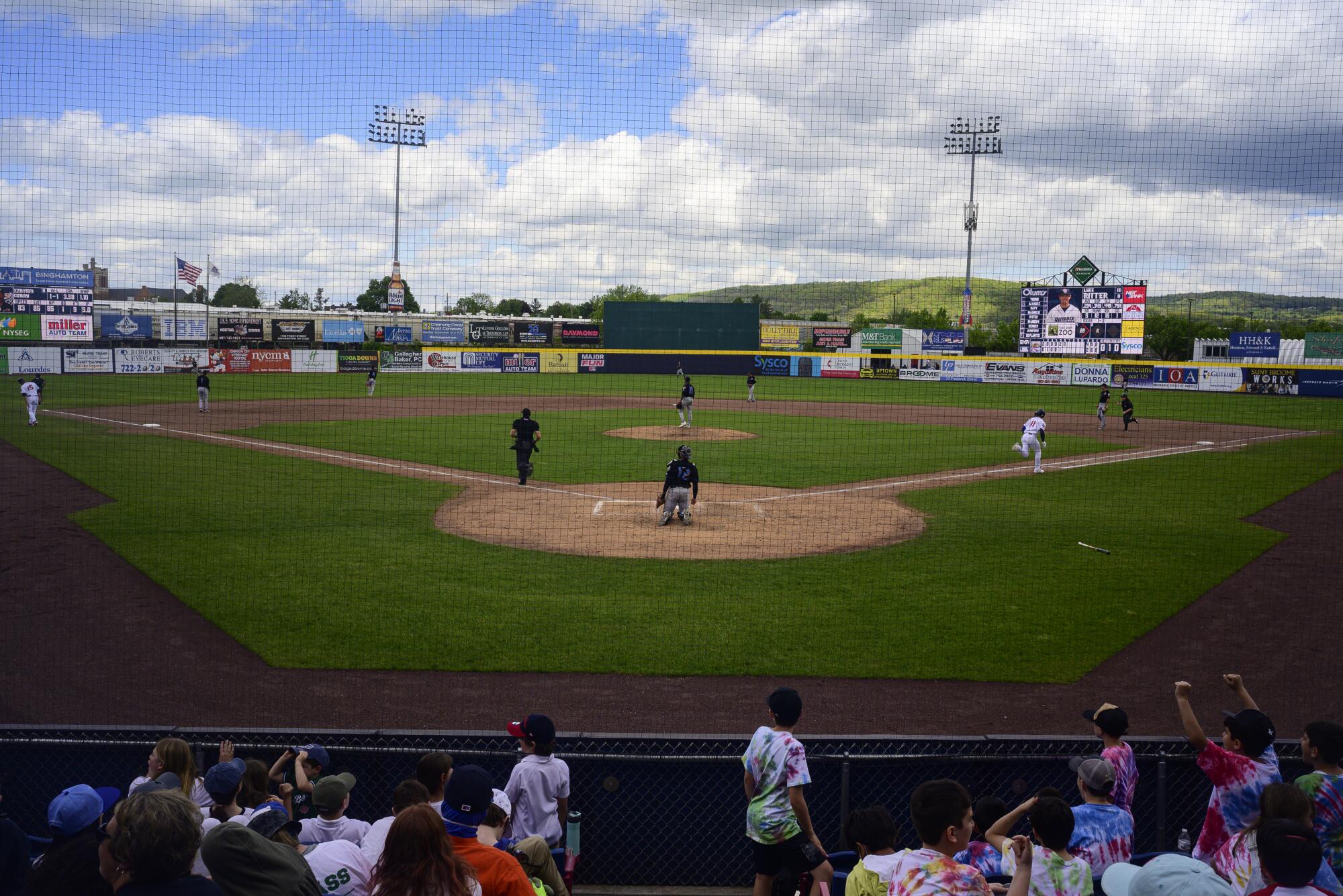
“Around Binghamton there’s a lot of misunderstanding of other people, and there’s a lot of room for these extremists to groom young people,” he said. “You get out into Conklin, some of those smaller towns where it’s 98% white and … you’re not exposed to different cultures, you make up your mind and you develop misconceptions and they grow into hate.”
Kent Schull, chair of the history department at Binghamton University, has a close relative in a mixed-race marriage living in Conklin. The couple, who identify as members of the LGBTQ community, told him “they’ve felt very safe.” Though “they do get stares,” he said, they have never mentioned encountering hostility.
At the same time, Schull said he sees “maybe even more” Confederate flags in upstate New York than he ever did when he lived in Memphis, Tenn., from 2007 until 2012. And he said that when his kids’ sports teams play at schools in some of the whiter, more rural parts of the area, they often find themselves on the receiving end of hateful remarks, both from other players and from their parents.
“We get told we’re coming from the ghetto because we have a diverse soccer team,” he said. “They get called thugs and that kind of thing.”
Binghamton presents a familiar northeast Rust Belt scene, one of a string of former industrial hubs across the Northeast now recasting themselves as medical and academic centers.
IBM was founded just west of Binghamton in 1911, and the city’s population peaked in the 1950s and 1960s, when it hovered around 80,000, before steadily declining to about 47,000 as of the 2010 U.S. census. In 2020, the population remained just under 48,000.
This is the land of a Bruce Springsteen song: Many companies have shuttered factories and office buildings and left town in recent generations. Binghamton University and area medical centers and hospitals have simultaneously expanded, but they haven’t generated enough jobs to kick off a new period of rapid population rise. Neither have newer commercial facilities like the Amazon distribution center that opened in Conklin last year.
And so the city’s population has stagnated, driving many young people to move away to larger cities in search of jobs and opportunity. It’s not a new phenomenon, and it’s not limited to Binghamton. In 2006, the New York Times raised the alarm over U.S. census data showing that Broome was one of 13 upstate New York counties that saw a more than 30% decline in their populations of people ages 25 to 34 between 1990 and 2004.
Mike Maciak has lived in the Binghamton area since he was born in 1952. He said he believes “things have really changed” in this area over the last 20 years, leaving young people with few options for the future.
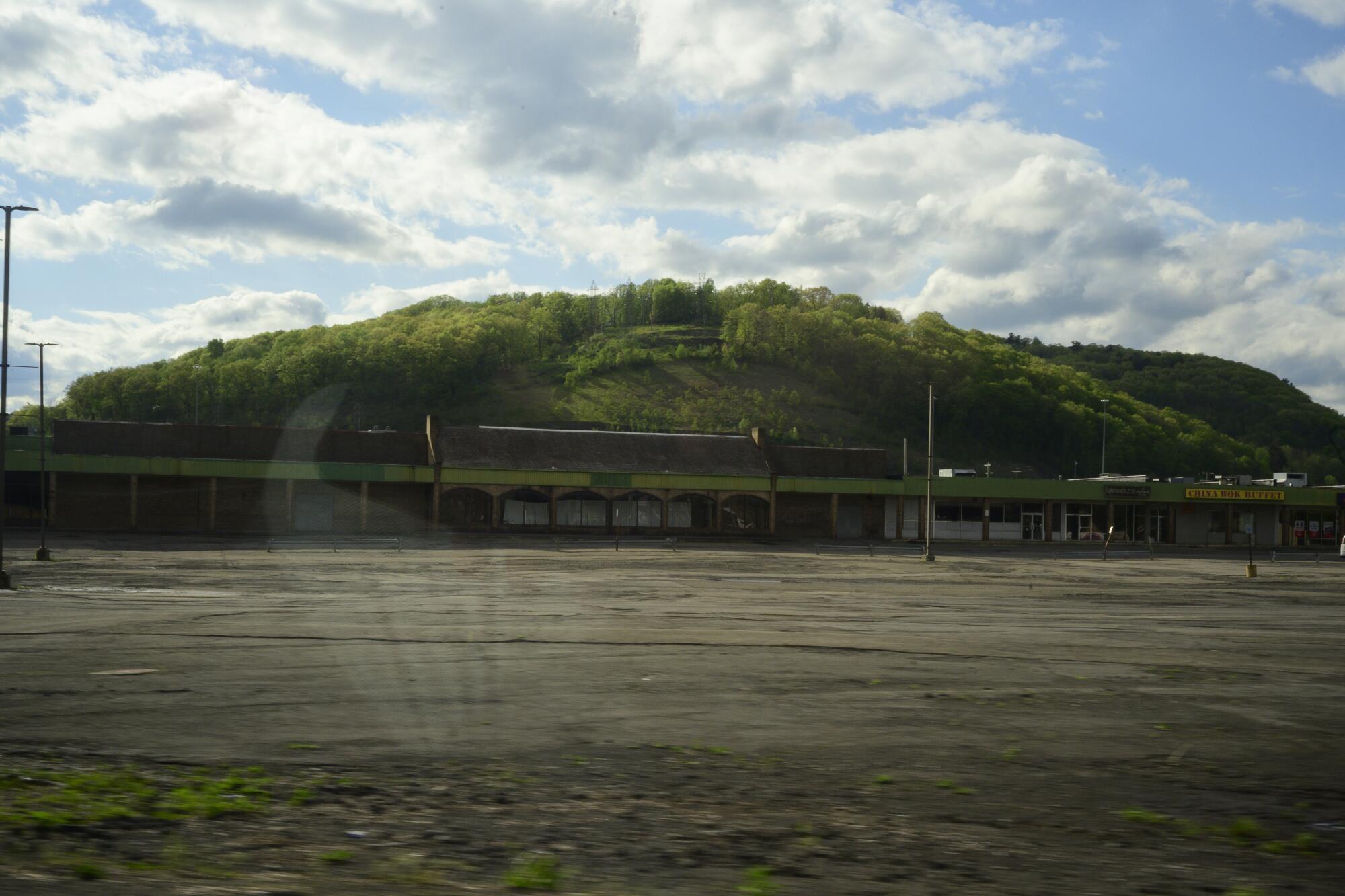
It’s also left the town with a dearth of workers, which affects local businesses, said Dick Jordan, a lawyer who lives in rural Pennsylvania, just five miles from the state’s border with Conklin.
“You can’t find any help here,” he said. “You can’t even find anyone to clean your house.”
Green, the longtime Conklin resident, who moved away during the COVID-19 pandemic, seconded that notion. He said that Binghamton used to be a boomtown, but that those days are long gone.
“I grew up in this area. It’s changed a lot. This is the birthplace of IBM; they used to have 13,000 employees in downtown Endicott. They’re down to maybe a couple hundred people,” he said. “Just like a lot of other parts of the country, we’ve lost a lot of jobs.”
It’s unclear whether Gendron felt the job crunch. But he dropped out of community college without getting a degree. He worked in the deli section at Reliable Market, a small grocery store in Conklin, for several months before quitting three months ago, said the market’s owner, who declined to provide his name.
The unemployment rate in the Binghamton metro area was just 4.2% as of March, according to federal labor data. But for a teenage high school graduate without a degree, it’s difficult to find anything beyond a minimum-wage job. Of which there are plenty, according to Fleury, the community college student.
“There’s so many jobs here, like in fast food,” said the 19-year-old, who works at a Sonic Drive-In.
The extent of the influence of this place on Gendron and the formation of the extreme views that allegedly led him to carry out the Saturday attack will probably never be known. But he grew up in this community. This is the air he breathed. And more than a decade ago, Binghamton produced a mass shooter who is believed to have acted at least partly in response to intolerance and lack of cultural understanding.
In April 2009, Jiverly Antares Wong shot and killed 13 people and injured four more, then killed himself. Wong, who was fluent in Vietnamese, carried out the shooting inside a business where he had taken courses that year to improve his English.
At the time, Binghamton Police Chief Joseph Zikuski said on NBC that the 41-year-old had been angry about the fact that he had been “degraded and disrespected” for his substandard English skills.
“It’s bigotry, and not just against African American people but also people of other races, religions,” Longo said when asked to characterize the views of many residents of nearby rural areas.
“Am I surprised that something like that [massacre] came out of Conklin? No.”
- Share via
Watch L.A. Times Today at 7 p.m. on Spectrum News 1 on Channel 1 or live stream on the Spectrum News App. Palos Verdes Peninsula and Orange County viewers can watch on Cox Systems on channel 99.
More to Read
Sign up for Essential California
The most important California stories and recommendations in your inbox every morning.
You may occasionally receive promotional content from the Los Angeles Times.
